
REPRINTS

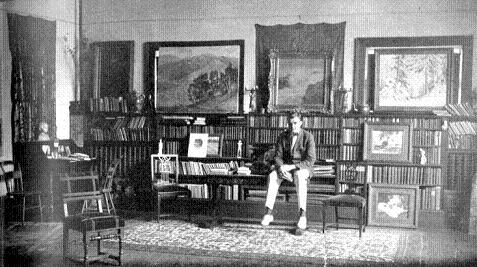
In Manchester, the name "Cheney" brings to mind Cheney Brothers, the Industrial Revolution, silk mills, and fashion design.
However, the Cheneys of Manchester were also, among other things, educators, philanthropists, writers, and artists.
Russell Cheney (1881-1945) was one of those artists. He painted in Manchester for a time, but traveled widely in the
United States and Europe, creating canvases of the local landscapes, portraits, still lifes, and interiors. We can see
examples of his work at Manchester's town hall, the public libraries, and the Historical Society, and we can decide if we
agree with the critics who say that he was influenced by Paul C�zanne, or if we see Russell's unique vision in his paintings.
Russell was the youngest of eleven children born in Manchester to Knight Dexter (K.D.) and Ednah Dow Cheney. His
grandfather, Charles Cheney, was one of the Cheney brothers who founded the world-famous silk mills. Russell followed many
family traditions, such as graduating from Hartford Public High School and from Yale, but not the tradition of entering the
silk business. He wasn't alone in this, for two great-uncles � John and Seth Cheney � were artists and engravers, and a
second cousin � Charles Adams Platt � was an engraver, artist, landscape architect, and later a popular architect of grand
homes and institutions, including several in Manchester and Rockville.
But unlike John and Seth Cheney, whose lucrative artwork helped finance the silk manufacturing in its early days,
Russell was supported by his family while he made his way in the art world. After graduating from Yale in 1904, he studied
at Art Students League in New York until 1907, when he went to the Acad�mie Julian in Paris.
The Artist's Studio
Part of an 1835 barn on the family property was made into a studio for Russell, and he painted there from 1912 through
the 1920s. The two-story studio had a large north-facing window. There was also a set of outbuildings along the side, with
extra residential space, and nearby, a large carriage house and garage. The studio at 30 Forest Street was later converted
by Cheney family member Horace Learned and his family into a large residence, using the studio as a great hall, a setting
for the many parties that they threw. The house wasn't as elegant as the nearby family mansions, but it is large for a
house � over 4,600 square feet.
When I interviewed Roger Olcott (1913-2002) who grew up across the street from the studio, he spoke affectionately of
his relative Russell Cheney. Roger's mother was a Cheney family member, and she appreciated and encouraged Russell's
painting.
Roger and his cousins used to visit Russell Cheney's studio, for the cousins had the run of the Great Lawn and various
Cheney homes.
Roger said that Russell Cheney "was painting away there. I remember going in to his studio with cousin Timothy Cheney,
who was just my age. We'd wander in there, as all of us did, and one time Timothy asked him what his favorite color was.
�Yaller,' he said, and he pronounced it that way. I think he meant bordering a little toward the orange, maybe."
The house still stands on Forest Street, not far from the Army and Navy Club in Downtown Manchester. The huge window is
still there, as Roger Olcott described it, "He had the north light here, the great big window, and over here, his easel.
This is where he put up his stuff to paint. This would be perfectly dark except for the north light. The studio was just
the way an artist would want it� There was no showmanship to it, but it was just excellent" for painting.
Painting in Maine and Around the World
Russell Cheney eventually moved to Kittery, Maine. He and his partner, writer and critic F.O. Matthiessen, bought an
old house there in 1930, and added a studio on the grounds. Russell continued to travel and paint in California, the
southwest, and Europe. He had numerous one-man and group shows, including at the Wadsworth Atheneum in Hartford.
In his still life paintings, he often included unusual figurines, which he mentions in this April 1925 letter:
"South Manchester, Connecticut. It's good to be home and quiet. Came up this morning [from New York after the sea
voyage from Europe] and all afternoon was round the studio clearing up, getting out my various Chinese lares and penates.
The tall white porcelain Kwanyin, Goddess of Mercy, for her place on my desk. The Siamese Buddha, slim boyish figure, the
side face an elusive half smile, the front cruel and inhuman�Gosh how I love getting them out and placing them �I love
handling them and never tire of them�.All the way up on the train, I sat quietly dreaming along, happy in the fresh green
landscape, the willows really out, the maple blossoms showing red and yellow�I think some of painting an interior of the
Homestead�reflections of the sunny green lawn outside on the white paint inside, the lovely shapes of the delicate mahogany
chair backs and slender table legs." � letter quoted in "Russell Cheney, 1881-1945, A Record of His Work, With Notes by F.O.
Matthiessen,"
His health was poor � he spent two years in a Colorado tuberculosis sanatorium � and subsequently spent winters in warm
climes. In 1945, he died of a heart attack in Kittery. His funeral was in Manchester, and he is buried in the Cheney
Cemetery, off East Center Street. His remaining paintings were disposed of by his partner F.O. Mathiesson. A collection of
them was displayed at the old Cheney Office Building on Hartford Road, and relatives could pick what they wanted to take
home.
In a 1947 column in The Christian Science Monitor, art critic Dorothy Adlow comments on Cheney's death: "The mood of
ebullience, the spontaneity and sparkle of the Cheney paintings, the note of affirmation, has temporarily gone out of most
American painting."
Russell Cheney paintings today are in museum collections and in private residences. Vivian Ferguson, Town Historian,
acquired two paintings � Yellow Roses, at a local auction, and The Cathedral at Chartres, from the former owners of the
house that she and her late husband, Tom, bought in 1958. Paintings occasionally come up for sale at online auctions and
galleries.
In 2008, there were two Russell Cheney exhibits open to the public in Portsmouth, N.H.: at the Portsmouth Athenaeum and at the Portsmouth Historical Society's Discover Portsmouth Center. In 2001, the Manchester Historical Society hosted an exhibit of Cheney paintings, some of which can be seen at the Old
Manchester Museum on Cedar Street, and others of which were borrowed from collectors in the community.
During August, 2008, a one-hour Manchester Historical Society television program about Russell Cheney's studio and work aired on local public access Cox cable.
For more information about the artist, visit www.russellcheney.com.
Ed. Note
• The memoirs of Seth W. Cheney are available online on Google Books, which you can access either from
the Vintage Reprints section of our
web site, or by clicking
here.
• The memoirs of John Cheney are also available online on Google Books, which you can access either from
the Vintage Reprints section of our
web site, or by clicking
here.
• Additional information on Charles Adams Platt can be found in this web site on the Cheney Brothers National
Historic Landmark District Map by clicking here,
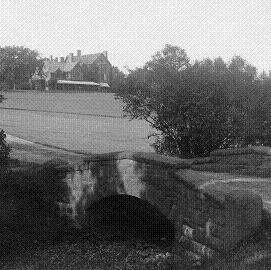
Cheney house where Russell grew up. 1903 photo in the collection of the Manchester Historical Society. The house was extensively remodeled for K.D.'s son (Russell's brother) Philip Cheney in the 1920s. Coincidentally, it was Russell's second cousin, Charles Adams Platt (1861-1933), who redesigned the house, including planning the garden and selecting the furniture and wall coverings.
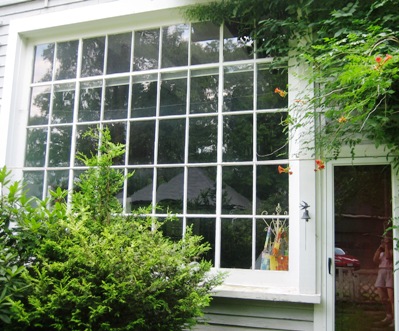
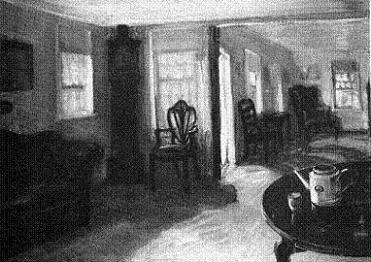
Oil painting of the John Mather house on Mather Street by Russell Cheney (1881-1945). This painting is at the Masonic Temple on East Center Street in Manchester. Russell Cheney painted it in honor of his father, Knight Dexter Cheney, who was a Mason from 1860 until his death in 1907.
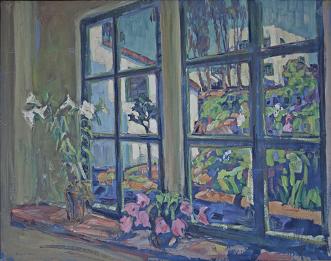
This painting, Vitrine (French for window), hangs in the Mary Cheney Library on Main Street in Manchester, CT. Russell Cheney painted it in 1921 in Santa Barbara. In the 1947 book, "Russell Cheney 1881-1945 A record of His Work with Notes," author and Russell's partner F.O. Matthiessen says of Vitrine, "...he treated what was to become a favorite motif, flowers against a window, combining thereby still life with landscape." Contemporary photo of this painting courtesy Dick Jenkins.
This painting, "Tapestry," is in the collection of Kevin and Jill Mack of Manchester, members of the Manchester Historical Society. A paper tag stapled to the back of the frame documents that it was exhibited at the Wadsworth Atheneum, the art museum in Hartford. Jill purchased it from a woman in Storrs, who received it as a gift from a friend who moved. The friend's husband worked in Boston, and Jill commented that "it may have been connected somehow to Russell's partner, F.O. Matthiessen."